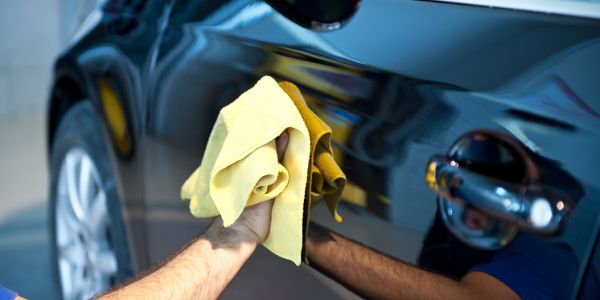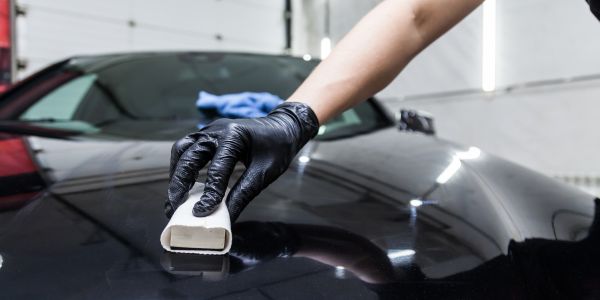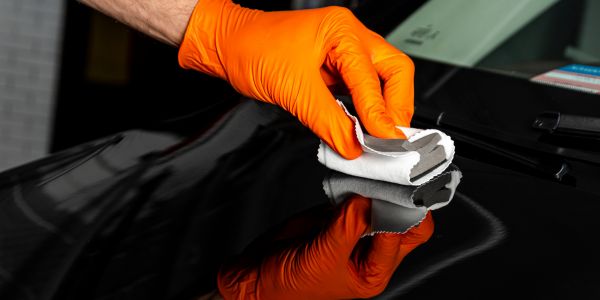Ceramic coatings have taken the automotive world by storm, offering unrivaled protection and aesthetics for vehicles. These coatings are celebrated for their ability to provide a long-lasting shield against environmental elements and maintain a glossy finish. Yet, an intriguing question often arises in the world of car enthusiasts: Can you wax ceramic coating?
In this exploration, we will dive into the realm of ceramic coatings, highlighting their advantages and addressing the common query regarding the compatibility of wax with these advanced protective layers. Let’s unveil the secrets of ceramic coating and the role of wax in its maintenance.
Understanding Ceramic Coating: A Revolution in Automotive Care

Defining Ceramic Coating’s Rise in Popularity:
Ceramic coating is a cutting-edge automotive detailing solution that has gained immense popularity in recent years. It’s a liquid polymer that is applied to a vehicle’s exterior surfaces, bonding chemically with the paint to create a protective, semi-permanent layer. Car enthusiasts and professionals alike have embraced ceramic coatings for their ability to enhance a vehicle’s appearance and durability.
Unveiling the Protective Properties of Ceramic Coating:
Ceramic coatings offer a superior level of protection compared to traditional waxes. These coatings form a robust, hydrophobic barrier that repels water, dirt, and contaminants. They are highly resistant to UV rays, oxidation, and chemical exposure, effectively shielding the paint from damage and fading. Unlike wax, which may require frequent reapplication, ceramic coatings can last for several years, making them a cost-effective choice for long-term vehicle protection.
The Ease of Cleaning and Maintenance with Ceramic Coatings:
One of the standout advantages of ceramic coatings is their ease of maintenance. The ultra-smooth surface created by the coating minimizes dirt and grime adhesion, making washing the vehicle a breeze. Additionally, the hydrophobic properties mean that water and contaminants slide off easily, leaving the car cleaner for longer periods. This convenience has contributed significantly to the widespread adoption of ceramic coatings in the automotive industry.
As we explore further, we’ll address the intriguing question of whether waxing is necessary or advisable on top of a ceramic coating, considering its already impressive protective qualities.
The Functionality of Wax: Balancing Shine and Protection
The Role of Traditional Car Waxes:
Traditional car waxes have long been trusted for their ability to enhance a vehicle’s shine and create a protective barrier. They typically contain natural or synthetic wax compounds, such as carnauba or synthetic polymers, which provide a glossy finish and a level of protection against elements like water, UV rays, and minor contaminants. Waxing serves as a time-honored method to keep vehicles looking their best and extend the life of the paint.
The Misconception about Wax and Ceramic Coatings:
There is a common misconception that waxing can degrade or damage ceramic coatings. However, this notion stems from a misunderstanding of how these two products interact. In reality, when properly applied, wax can coexist with ceramic coatings without causing harm. The key is to ensure that the wax is compatible with the coating and that it is used as an additional protective layer rather than as a replacement.
Understanding Wax Compositions and Interactions:
Waxes come in various compositions, ranging from natural carnauba waxes to synthetic polymers. The interaction between wax and ceramic coating depends on the specific formulation of the wax and the characteristics of the ceramic coating. Some waxes may bond effectively with ceramic coatings, providing an extra layer of gloss and hydrophobicity, while others may not adhere well and can diminish the coating’s benefits.
In the next sections, we will explore the guidelines and best practices for using wax on top of ceramic coatings to strike a balance between shine and protection without compromising the integrity of either product.
The Compatibility of Wax and Ceramic Coating: A Harmonious Duo
Debunking the Myth: Wax and Ceramic Coatings Can Coexist:
Contrary to the misconception, wax and ceramic coatings are not mutually exclusive. With proper knowledge and application, they can complement each other effectively. Ceramic coatings form a durable, hydrophobic layer, while wax enhances gloss and offers additional protection. The key is understanding how to make this combination work seamlessly.
Examples of Suitable Waxes for Ceramic-Coated Surfaces:
There are waxes designed explicitly for use on ceramic-coated surfaces. These waxes are formulated to bond effectively with ceramic coatings and provide added shine and protection. Some reputable products include ceramic-specific spray waxes or those labeled as “ceramic-friendly.” They are engineered to enhance the coating’s longevity and hydrophobic properties without compromising its integrity.
The Significance of Composition Understanding:
Understanding the composition of both the wax and the ceramic coating is paramount. Compatibility hinges on factors like the chemical makeup and bonding characteristics of the products. For instance, traditional carnauba waxes may not bond well with ceramics, while synthetic or hybrid waxes tend to offer better compatibility. Always read product labels and follow manufacturer recommendations for the best results.
As we delve deeper into the world of waxing ceramic-coated surfaces, we’ll explore the step-by-step process of applying wax to maximize shine and protection while preserving the benefits of your ceramic coating.
Tips for Waxing Ceramic Coating: Achieving the Perfect Balance

Step-by-Step Application Guide:
When waxing a ceramic-coated surface, follow these recommended steps:
- Surface Preparation: Ensure the surface is clean and free of contaminants. Wash the vehicle using a pH-neutral or wax-specific cleaner.
- Surface Inspection: Examine the ceramic coating for any signs of wear or damage. Touch up or reapply the coating if necessary.
- Choosing the Right Wax: Select a wax specifically designed for ceramic coatings or labeled as “ceramic-friendly.”
- Application: Apply the wax using a soft, clean applicator pad or microfiber cloth. Use gentle, circular motions to spread the wax evenly.
- Buffing: Allow the wax to haze over for the recommended time specified by the wax manufacturer. Then, use a clean, dry microfiber cloth to buff the surface to a high shine.
Surface Preparation Is Key:
Properly preparing the surface is paramount to ensure the wax bonds effectively with the ceramic coating. Contaminants like dirt, road grime, or residual products can hinder adhesion. Thoroughly wash the vehicle using a pH-neutral or wax-specific cleaner to remove any impurities.
The Importance of pH-Neutral or Wax-Specific Cleaners:
Using a pH-neutral or wax-specific cleaner before waxing serves several purposes:
- It removes contaminants that can interfere with wax adhesion.
- It ensures the ceramic coating is clean and free from any residues that might inhibit the bonding of the wax.
- It maintains the hydrophobic properties of the ceramic coating, allowing water to bead off effectively.
By following these steps and using the right products, you can achieve a harmonious balance between your ceramic coating’s protection and the enhanced shine provided by wax, resulting in a stunning, well-maintained finish.
Maintenance and Precautions: Safeguarding Your Ceramic Coating

The Vitality of Regular Maintenance:
Regular maintenance is the lifeline of your ceramic coating’s longevity. To ensure its ongoing effectiveness, it’s essential to adhere to a routine maintenance schedule. This includes routine washing and inspections to identify any wear or damage to the coating. Promptly addressing any issues can prevent them from escalating and compromising the protection provided by the ceramic coating.
Beware of Potential Risks:
Certain wax products may pose risks to your ceramic coating. Waxes containing abrasives or silicones can diminish the coating’s hydrophobic properties and longevity. Abrasive compounds can wear down the coating, while silicones can create a barrier that inhibits its effectiveness. Therefore, it’s crucial to choose waxes that are designed for compatibility with ceramic coatings, avoiding those with potentially harmful ingredients.
Exploring Alternative Options: Ceramic-Infused Waxes and Sealants:
If you’re hesitant about using traditional waxes, consider ceramic-infused waxes or sealants as alternatives. These products are formulated to enhance the performance of ceramic coatings. They can provide the added gloss and protection you desire without compromising the benefits of your ceramic coating. Always check product labels for compatibility and follow manufacturer recommendations.
By embracing regular maintenance, making informed product choices, and exploring alternative options, you can ensure your ceramic coating continues to shine and shield your vehicle for an extended period. These precautions will help you maintain the harmonious balance between protection and aesthetics that ceramic coatings offer.
FAQs
Can I apply wax immediately after applying a ceramic coating?
It’s generally recommended to wait for the ceramic coating to cure fully before applying wax. This curing period can vary depending on the product, so consult the manufacturer’s instructions. Usually, it’s best to wait at least 24-48 hours.
Is it necessary to wax a vehicle with a ceramic coating?
It’s not necessary, but it can enhance the appearance and provide additional protection. Ceramic coatings offer robust protection on their own, but waxing can add extra shine and act as a sacrificial layer, taking the brunt of environmental contaminants.
Can I use any wax on a ceramic-coated surface?
No, not all waxes are suitable for use on ceramic-coated surfaces. It’s essential to choose waxes specifically designed for this purpose or those labeled as “ceramic-friendly” to ensure compatibility and prevent potential issues.
How often should I wax a ceramic-coated vehicle?
The frequency of waxing depends on several factors, including the environmental conditions your vehicle is exposed to and the specific wax product you use. In many cases, a few times a year is sufficient to maintain the coating’s shine and protection.
Can I use ceramic-infused waxes as an alternative to traditional waxes on ceramic-coated surfaces?
Yes, ceramic-infused waxes are designed to enhance the performance of ceramic coatings. They can provide similar benefits to traditional waxes while maintaining compatibility with ceramic coatings.
Can waxing a ceramic coating damage the coating itself?
When done correctly with compatible products, waxing should not damage the ceramic coating. However, using the wrong type of wax, such as abrasive or silicone-containing waxes, can have adverse effects on the coating.
Can I apply ceramic coating on top of wax?
It’s not advisable to apply ceramic coating on top of wax. The coating should be applied to clean, bare paint for optimal adhesion and performance. If your vehicle already has wax on it, it’s best to remove the wax before applying ceramic coating.
Remember to read the product labels, manufacturer recommendations, and follow proper application procedures to ensure the best results when combining wax and ceramic coatings.
Conclusion
In the realm of automotive care, the relationship between ceramic coatings and wax has often been shrouded in myth and misunderstanding. However, we’ve unveiled the truth: you can indeed wax ceramic coatings, provided it’s done mindfully and with the right products.
Ceramic coatings bring a new era of protection and longevity, while traditional waxes offer enhanced shine and additional safeguarding. When applied correctly, these two can coexist, with each product complementing the other’s strengths.
To achieve this harmonious balance, follow the recommended steps for waxing ceramic coatings, prioritize proper surface preparation, and choose waxes specifically designed for this purpose. Regular maintenance is the key to preserving your ceramic coating’s vitality, and alternative options like ceramic-infused waxes and sealants provide additional choices for those seeking the perfect shine.
So, the answer is clear: you can wax ceramic coating. Embrace this blend of innovation and tradition to keep your vehicle looking pristine and protected for years to come.